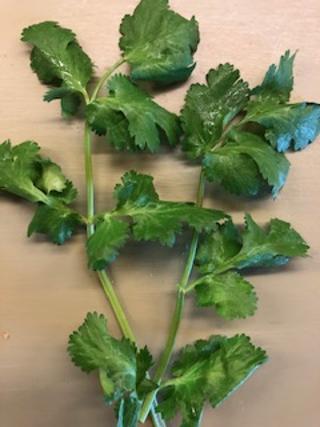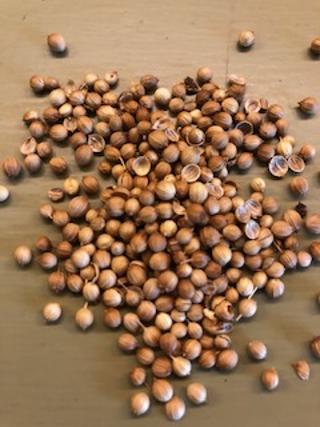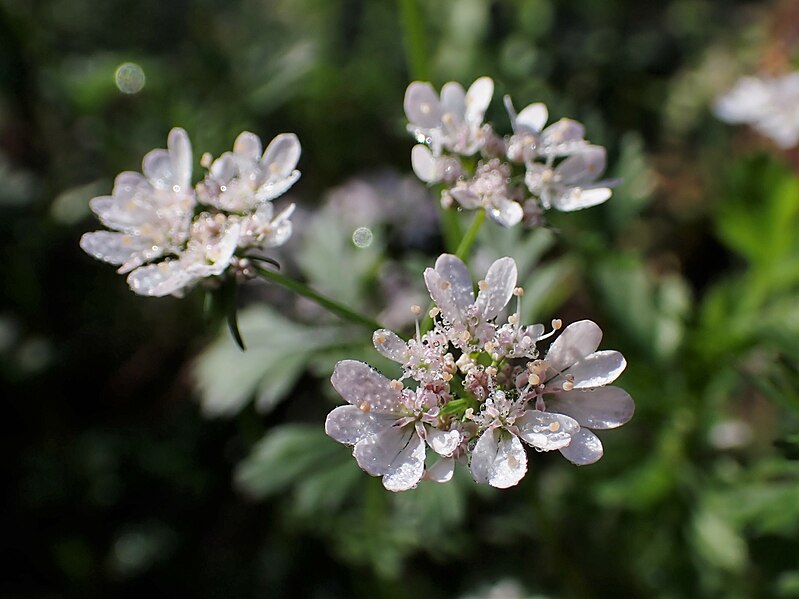By Maryann Readal
 Cilantro (Coriandrum sativuum) is an herb that elicits strong feelings of like or dislike. Those who like the herb appreciate its sagey-lemony flavor. Those who do not like it say that it tastes like soap or chemicals. Dr. Vyas of the Cleveland Clinic explains that “those who dislike cilantro tend to have a gene that detects the aldehyde part of cilantro as a soapy smell and taste” (Cleveland Clinic, 2020). These are the people who do not relish the taste of cilantro in their food. There appears to be little middle ground for appreciating the taste of cilantro.
Cilantro (Coriandrum sativuum) is an herb that elicits strong feelings of like or dislike. Those who like the herb appreciate its sagey-lemony flavor. Those who do not like it say that it tastes like soap or chemicals. Dr. Vyas of the Cleveland Clinic explains that “those who dislike cilantro tend to have a gene that detects the aldehyde part of cilantro as a soapy smell and taste” (Cleveland Clinic, 2020). These are the people who do not relish the taste of cilantro in their food. There appears to be little middle ground for appreciating the taste of cilantro.
The leaves, roots, and seeds of cilantro (the seeds are called coriander) are all edible. The seeds have a softer flavor and none of the objectionable taste of the leaves. It is interesting to note that in Europe and other countries, both the leaves and the seed are called coriander. In the US and Canada, the leaves of the plant are called cilantro and only the seeds are called coriander. Sometimes the herb is also referred to as Chinese parsley or Mexican parsley.
 Cilantro originated in southwestern Asia and North Africa. Coriander, which is the seed of the plant, has been found in 8,000 year old caves in the Judean desert. The seeds were placed in the tombs of King Tut and Ramses II for their journey to the afterlife, and the Bible’s Book of Exodus compares coriander to manna that fell from heaven. Ancient Hebrews considered it one of the bitter herbs used during Passover. Its use has been recorded in ancient Chinese writings from 200 BCE, where it was thought that eating the
Cilantro originated in southwestern Asia and North Africa. Coriander, which is the seed of the plant, has been found in 8,000 year old caves in the Judean desert. The seeds were placed in the tombs of King Tut and Ramses II for their journey to the afterlife, and the Bible’s Book of Exodus compares coriander to manna that fell from heaven. Ancient Hebrews considered it one of the bitter herbs used during Passover. Its use has been recorded in ancient Chinese writings from 200 BCE, where it was thought that eating the  seeds would make one immortal. Arabs and Chinese both believed that it also stimulated sexual desire. It is mentioned in the Arabian classic, The Thousand and One Nights, as an aphrodisiac (Kowalchick, 1998), while the Roman botanist Pliny called it “a very stinking herb.” In fact, it was given the name “koris,” the Greek word for stinkbug or bedbug, because of its smell when squashed. In Pliny’s day, it was used as an antidote to poison, to heal sores, and to rid the body of parasites. Charlemagne loved it so much that he planted it in all of his gardens. The herb was brought to the New World in the 1600s where it became popular in Mexican and Latin American cuisines.
seeds would make one immortal. Arabs and Chinese both believed that it also stimulated sexual desire. It is mentioned in the Arabian classic, The Thousand and One Nights, as an aphrodisiac (Kowalchick, 1998), while the Roman botanist Pliny called it “a very stinking herb.” In fact, it was given the name “koris,” the Greek word for stinkbug or bedbug, because of its smell when squashed. In Pliny’s day, it was used as an antidote to poison, to heal sores, and to rid the body of parasites. Charlemagne loved it so much that he planted it in all of his gardens. The herb was brought to the New World in the 1600s where it became popular in Mexican and Latin American cuisines.
In Europe, coriander seeds were coated with layers of sugar and were served after dinner as a digestif. Many of us grew up with the famous Christmas poem “Twas the Night Before Christmas” (or “A Visit from St. Nicholas”) by Clement C. Moore where we read that “the children were nestled all snug in their beds, while visions of sugar-plums danced in their heads” (Moore, 1822). The sugar-plums in the poem referred to candied seeds such as coriander that were popular in1822 when the story was written.
 Thai cuisine relies heavily on cilantro leaves, seeds, and roots to flavor salads, soups, curry pastes, and herb mixes. Middle Eastern cuisines use the herb to enhance flavor in food and use it as a garnish. However, some modern chefs and herbalists echo the familiar dislike of the herb. Julia Child in a television interview in 2002 said, “Cilantro and arugula I don’t like at all. They’re both green herbs, they have kind of a dead taste to me.” Asked if she would ever order it, Child responded: “Never, I would pick it out if I saw it and throw it on the floor” (Denker, n.d.). Despite the strong opinion of Ms. Child and others, cilantro adds flavor and color to our Southwestern cuisine. Salsa and guacamole would not be the same without cilantro leaves.
Thai cuisine relies heavily on cilantro leaves, seeds, and roots to flavor salads, soups, curry pastes, and herb mixes. Middle Eastern cuisines use the herb to enhance flavor in food and use it as a garnish. However, some modern chefs and herbalists echo the familiar dislike of the herb. Julia Child in a television interview in 2002 said, “Cilantro and arugula I don’t like at all. They’re both green herbs, they have kind of a dead taste to me.” Asked if she would ever order it, Child responded: “Never, I would pick it out if I saw it and throw it on the floor” (Denker, n.d.). Despite the strong opinion of Ms. Child and others, cilantro adds flavor and color to our Southwestern cuisine. Salsa and guacamole would not be the same without cilantro leaves.
The herb has been used medicinally for many, many years as well. The essential oil of cilantro is antimicrobial and antioxidant (Tucker, 2009). “Its oil flavors gin, vermouth, liqueurs, and tobacco, and is prized in perfumery” (Bown, 2001). Coriander is one of the original ingredients in the secret formula for Coca-Cola® (ABC News, 2011).
 Cilantro is easily sown directly into the garden, but it does prefer cooler weather. After about thirty days, white to pink umbels of flowers appear on a stalk rising from the center of the plant. These blossoms are attractive to bees and other beneficial insects and pollinators, while the leaves of the plant deter aphids and spider mites in the garden. It is an annual but reseeds easily ensuring that you have a constant supply of the flavorful herb—if you like it, that is.
Cilantro is easily sown directly into the garden, but it does prefer cooler weather. After about thirty days, white to pink umbels of flowers appear on a stalk rising from the center of the plant. These blossoms are attractive to bees and other beneficial insects and pollinators, while the leaves of the plant deter aphids and spider mites in the garden. It is an annual but reseeds easily ensuring that you have a constant supply of the flavorful herb—if you like it, that is.
Medicinal Disclaimer: It is the policy of The Herb Society of America, Inc. not to advise or recommend herbs for medicinal or health use. This information is intended for educational purposes only and should not be considered as a recommendation or an endorsement of any particular medical or health treatment. Please consult a healthcare provider before pursuing any herbal treatments.
Photo Credits: 1) Cilantro leaf (Maryann Readal); 2) Cilantro leaves adorning a Chinese cuisine dish (Wikimedia Commons); 3) Coriander/Cilantro seeds (Maryann Readal); 4) Illustration from “Twas the Night Before Christmas” poem (Maryann Readal); 5) Cilantro flowers (Wikimedia Commons, Krzysztof Ziarnek).
References
ABC News. 2011. Is this the secret Coke recipe? Accessed 2/14/24. https://abcnews.go.com/Business/coca-colas-secret-formula-revealed/story?id=12914877
Bown, Deni. 2001. New encyclopedia of herbs and their uses. London: Dorling Kindersley Limited.
Cleveland Clinic. 2020. Love it or hate it—the great cilantro debate. Accessed 2/13/24. https://health.clevelandclinic.org/do-you-love-or-hate-cilantro-the-reason-may-surprise-you
Denker, Joel. n.d. Saved from the “two-headed serpent,” the curious history of coriander. Accessed 2/11/24. https://www.foodpassages.com/jottings-by-joel/intowner-columns/saved-from-the-two-headed-serpent-the-curious-history-of-coriander-part-i/
Kowalchick, Claire and William H. Hyton. 1998. Rodale’s illustrated encyclopedia of herbs. Emmaus, PA: Rodale Press.
Salloum, Habeeb. 2020. Fresh coriander, an exotic herb since antiquity. Accessed 2/11/24. https://www.arabamerica.com/fresh-coriander-an-exotic-herb-since-antiquity-2/
Tucker, Arthur and Thomas Debaggio. 2009. The encyclopedia of herbs: a comprehensive reference to herbs of flavor and fragrance. Portland, OR: Timber Press.
Maryann is a member of The Herb Society of America’s Texas Thyme Unit in Huntsville, TX. She is a Texas Master Gardener and a certified Native Landscape Specialist with the Texas Native Plant Society. She lectures and writes about herbs and plants and does herb training for Master Gardener programs. She gardens among the pines in the Piney Woods of East Texas.
Leave a Reply